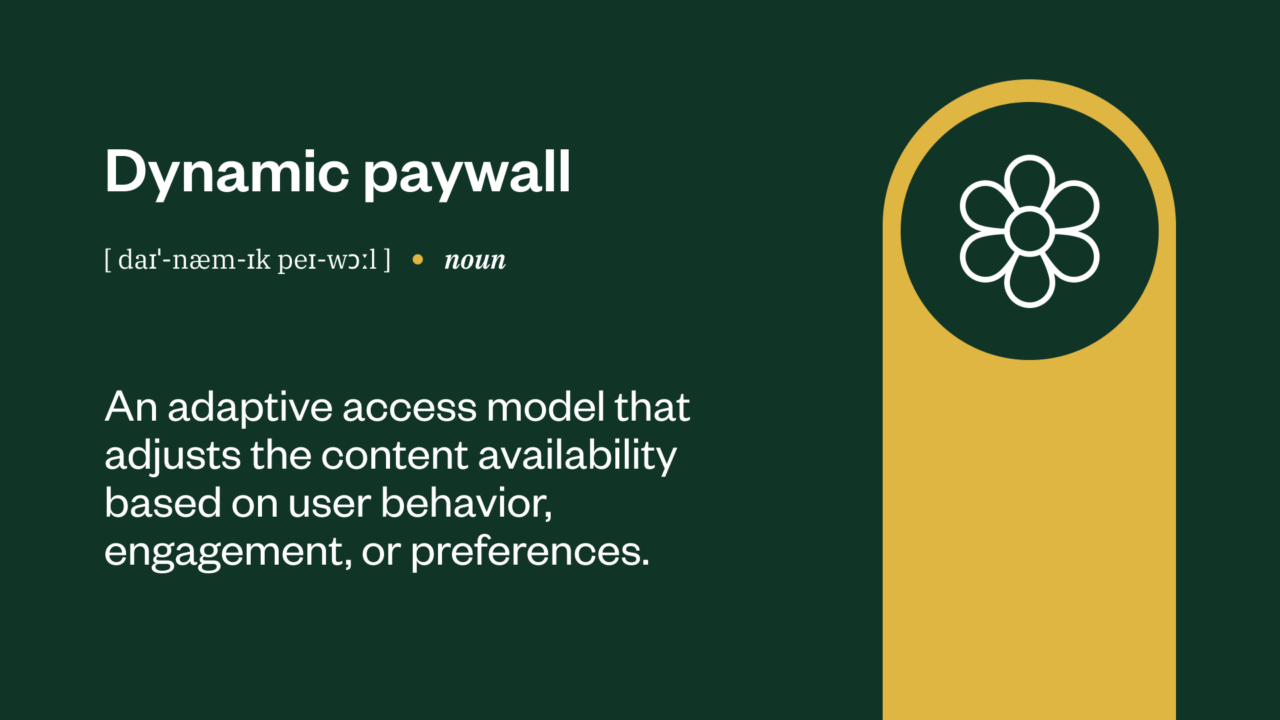Glossary Hub / Dynamic Paywall: Definition, Implementation, and Strategic Benefits
Dynamic Paywall: Definition, Implementation, and Strategic Benefits

There’s no denying that paywalls are now a key (and effective) source of revenue for publishers. But have you ever considered if you’ve got the right kind of paywall in place?
Unfortunately, it’s not always as simple as binary paid content versus free content, especially if you want to implement an effective and high-converting subscription funnel. There’s no longer space for a one-size-fits-all approach in the digital sphere because personalized user-experiences are the expectation, not the exception.
Tailored reader experiences are pivotal to shifting a casual readership into a committed subscriber, and this is where dynamic paywalls come in: intelligent paywalls that evolve with, learn from and react to each individual user. By using an intelligent paywall, you’ll gain key insights into your reader and see higher rates of conversion.
In this article, we cover what features make dynamic paywalls stand out and why they’ll change your digital subscription game for the better.
A quick intro to paywalls
Before we look in-depth at dynamic paywalls, it’s worth taking a quick look at the other types of paywalls to gain an overview of the different options available:
Hard paywall
A hard paywall is an impermeable gatekeeper to your content. If your readers want to access your content, they’ll have to pay. This requires you to have a substantial (and loyal) readership who are already committed to your publication. Hard paywalls make it hard to gain traction with potential subscribers because they have no way to try before they buy.
‘Soft’ or Freemium paywall
A freemium paywall tries to offer readers the best of both worlds. Publishers that use freemium paywalls segment their content, offering some for free and keeping others exclusive for paying subscribers only. This strategy rests on the hope that readers perusing your free content will be tempted (at some point) to pay the subscription fee.
Metered paywall
A metered paywall is the closest to a dynamic paywall. Readers get an ‘allowance’ of content they’re able to access for free within a set time period. Metered paywalls mean that first-time readers can peruse your content freely instead of being put off by an immediate hard paywall.
Key features of a dynamic paywall
A dynamic paywall breaks away from traditional static paywalls by offering an intuitive and constantly evolving paywall that adapts to each user’s behaviour.

Data-driven
Dynamic paywalls (and intelligent paywalls) harness user data to personalize each reader’s conversion strategy depending on their behaviours, interests and interactions. This first-party data also forms an invaluable resource for digital publishers to gain insights into their audience. You’ll be able to analyze metrics such as popular types of content, frequency of interaction, device type and more.
Tailored to the user
Driven by AI, dynamic paywalls result in personalized user experiences. So, unlike traditional paywalls, dynamic and intelligent paywalls are user-first rather than content-first. This creates a more engaged and satisfied audience and thus higher conversion rates.
Each individual reader enters a tailored customer journey that suits their wants and needs. For example, a user might face different article limits based on their interactions and engagement if the dynamic paywall judges that they’re likely to convert.
Optimised subscription funnel
Dynamic paywalls are highly effective because they’re constantly working to optimize and enhance your subscription strategies. Rather than a blanket policy, one-size-fits-all paywall, a dynamic paywall is constantly learning and relearning to deliver the best results possible. A dynamic paywall reacts to each user, and based on their behavior and interactions analyzes when and if a particular reader is prime for converting into a paid subscriber. Only at this crucial moment will it progress them through the subscription funnel.
How dynamic paywalls differ from static paywalls
Dynamic paywalls distinguish themselves from static paywalls through their adaptability and responsiveness to individual user behaviors. Unlike static paywalls, which present the same experience to every reader, dynamic paywalls customize the access to content based on real-time data analysis and personal preferences. This flexibility allows publishers to offer a more seamless and engaging user experience, thereby increasing the likelihood of conversion from casual readers to paying subscribers. As dynamic paywalls analyze a reader’s interactions, they can determine the precise moment to introduce subscription prompts, thereby enhancing the efficiency of the subscription funnel.
Furthermore, their data-driven nature ensures that publishers not only improve conversion rates but also gain deeper insights into audience behavior, empowering them to tailor content strategies to meet diverse and evolving audience needs. Through these innovative features, dynamic paywalls offer a compelling alternative to traditional methods by effectively balancing user experience with monetization goals.
How dynamic paywalls can drive growth
Stay agile & competitive
Dynamic paywalls and intelligent paywalls help keep your monetization strategy agile. Rather than resting your digital subscriptions on a static mechanism, you’re able to diversify your tactics and nurture a highly engaged and broad readership.
Dynamic paywalls are sure to become even more invaluable with the demise of third-party cookies this year. In order to continue gaining key insights into your audience, digital publishers will need to implement their own data collection strategies. Namely by introducing dynamic paywalls that continuously track user activities whilst simultaneously maximizing revenue streams.
Get to know & grow your audience
The data insights you gain from dynamic paywalls will help you learn about your audience. Harnessing this information, you’ll be able to effectively segment your audience, progressively profile each user, and thus pivot your content to better suit your readers.
The highly personalized and constantly adapting customer journey that is integral to dynamic paywalls ultimately prevent churn. And you’ll be able to reach a healthy balance between existing readers and new audiences, rather than ring-fencing your content.
Dynamic and digital go hand-in-hand
In a digital sphere that is constantly changing, it goes without saying that publishers need to develop digital monetization strategies that can keep up. Whilst conventional paywalls certainly have their merits, dynamic paywalls are one-step-up. The in-built intelligence of dynamic paywalls keeps you agile, at the same pace as your audience, and constantly at peak performance.
Is a dynamic paywall right for you?
There’s no right answer to this question. Your choice of paywall will relate directly to the size, nature and demographic of your readership. However, one thing is for certain, there is no one-size-fits-all approach anymore. You need to choose a paywall that works for and with you. Conventional paywalls work in the same way regardless of who you and your readers are.
Looking to take your paywall game to the next level, check out our paywall solutions!